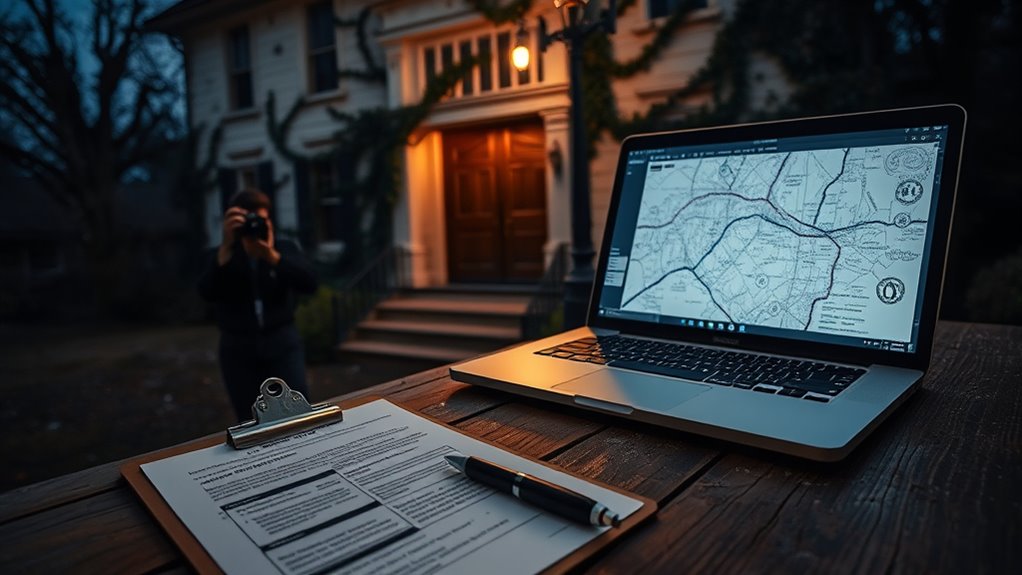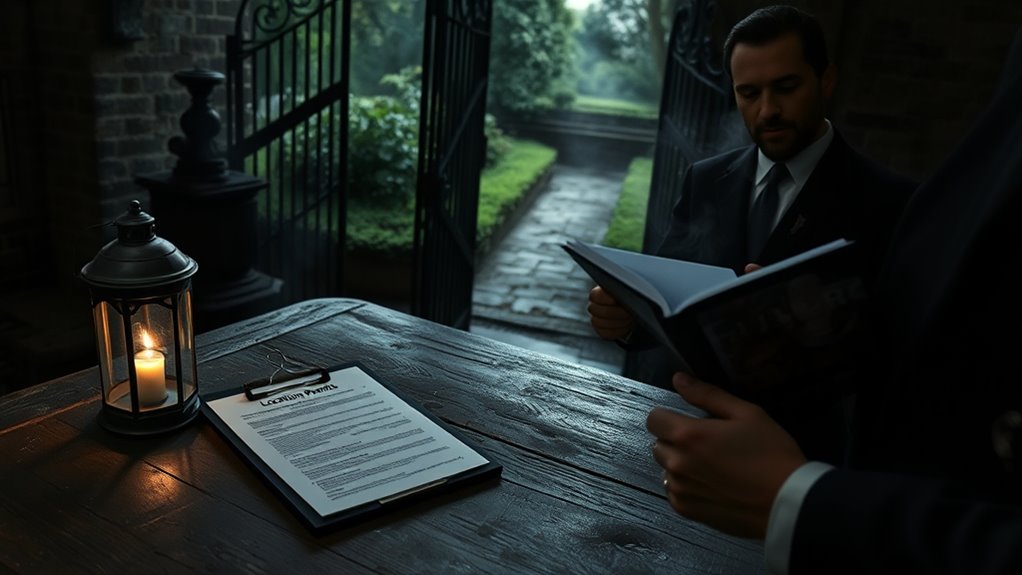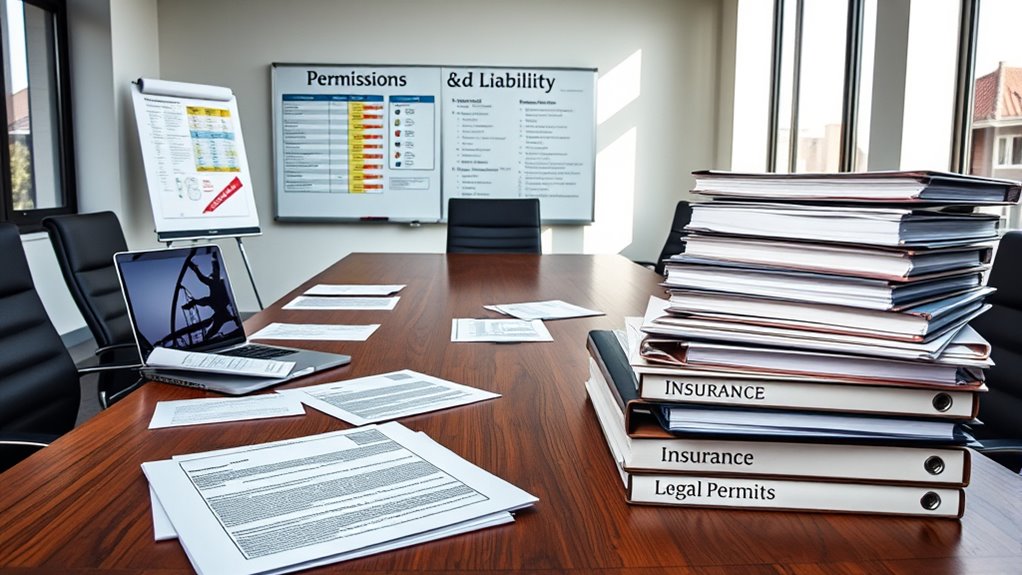To manage legal permissions for haunted filming, start by researching local regulations and securing necessary permits early, considering filming hours, safety rules, and special effects restrictions. Obtain permission from property owners with formal written agreements, and verify copyright or trademark clearances for music, images, or characters. Make sure you have thorough insurance, covering general liability, equipment, and stunts. Don’t forget to apply for permits related to special effects and props. Following these steps ensures smooth filming—keep exploring for detailed guidance on each step.
Key Takeaways
- Contact local film offices early to understand permit requirements and submission timelines.
- Obtain written property permissions detailing restrictions, access, and insurance obligations.
- Verify licensing for any copyrighted music, images, or trademarks used in the production.
- Secure appropriate insurance coverage for liabilities, equipment, and specialized effects or stunts.
- Submit detailed plans and obtain permits for special effects, props, or hazardous activities beforehand.
Understanding Local Regulations and Film Permitting Processes

Before you start filming your haunted scene, understanding the local regulations and the permit process in your filming location is vital. Each city or town has specific rules that govern filming activities, especially in public spaces or private properties. You need to research local ordinances related to noise levels, filming hours, and safety protocols. Contact the city or county film office early to learn about required permits and application procedures. Some areas might have restrictions on special effects, use of props, or blocking roads. Failing to comply can lead to fines, delays, or even shutdowns. Additionally, awareness of timing and dates for permit approvals can help you plan your production schedule effectively. By familiarizing yourself with these regulations upfront, you ensure a smooth production process and avoid legal complications during your haunted filming adventure.
Securing Location Permissions for Haunted Settings

Securing location permissions is a crucial step to guarantee your haunted filming runs smoothly and legally. You need to identify the property owner or management authority and request formal approval. Be clear about your filming dates, scope, and any special requirements. A well-prepared permission letter helps clarify expectations and protects both parties. Use the following table to organize key details:
| Property Details | Contact Information | Permission Conditions |
|---|---|---|
| Address & Description | Owner’s Name & Phone | Use Restrictions, Hours |
| Access Points | Email & Office Hours | Insurance & Liability |
| Special Requirements | Alt. Contact Info | Payment Terms |
This structure ensures you cover all essential elements and avoid issues during filming. Proper permissions safeguard you from legal complications and help create a seamless production environment. Additionally, understanding location management can facilitate smoother negotiations and ensure compliance with any specific property guidelines.
Navigating Copyright and Trademark Considerations

Managing copyright and trademark considerations is essential to avoid legal pitfalls during your haunted film project. Before filming, verify that you have permission to use any protected materials, such as music, images, or scripts. If your production features recognizable trademarks or copyrighted characters, you must secure licensing or rights from the owners. Using copyrighted works without permission can lead to costly lawsuits or injunctions that halt your project. To stay compliant, consider creating original content or using works with clear licensing, like royalty-free media. Keep detailed records of all permissions and licenses obtained. Being diligent in respecting intellectual property rights helps you avoid legal disputes, ensuring your haunted film stays on track and avoids costly setbacks.
Obtaining Necessary Insurance and Liability Coverage

To protect your haunted film project from potential financial and legal risks, obtaining the right insurance and liability coverage is vital. You need general liability insurance to cover accidents or property damage that could occur on set. If you’re using stunts, special effects, or pyrotechnics, specialized coverage becomes crucial to mitigate risks. Equipment insurance guarantees your gear is protected against theft, damage, or loss. Additionally, if your crew or actors sustain injuries, workers’ compensation insurance helps cover their medical expenses and legal liabilities. Always review policy details carefully to ensure they cover all aspects of your filming activities. Consulting with an insurance professional experienced in film production can help you select extensive coverage that safeguards your project against unforeseen incidents. For breeds like Labradoodles, choosing insurance that accounts for their unique coat and health needs can also be beneficial.
Managing Permits for Special Effects and Use of Props

After securing the right insurance coverage, the next step is to guarantee you have the necessary permits for your special effects and prop usage. You must check local regulations to determine which permits are required for using fire, fireworks, or other hazardous effects. Failing to obtain permits can lead to fines or filming stoppages. To stay compliant, communicate with city authorities and submit detailed plans of your effects and prop use. Additionally, understanding the role of AI ethicist jobs can help ensure your project adheres to evolving ethical standards related to safety and public impact.
Frequently Asked Questions
How Do I Handle Permits for International Haunted Filming Locations?
You should start by researching the specific country’s filming regulations and permit requirements. Contact local authorities or film commissions to understand the application process, fees, and necessary documentation. Be prepared to submit detailed plans, insurance proof, and possibly a local guide or liaison. Always verify if special permissions are needed for haunted or themed content, and guarantee all paperwork is approved before filming begins to avoid legal issues.
What Steps Are Needed for Drone Filming in Haunted Sites?
Did you know drone footage can boost haunted site tourism by 30%? To film with a drone at haunted sites, first, check local regulations and obtain necessary permits. Always guarantee your drone is registered and operated by a licensed pilot. Respect privacy laws and avoid disturbing visitors or wildlife. Coordinate with site authorities to secure permissions, and plan your shoots during off-peak hours for safety and minimal disruption.
How Can I Ensure Privacy Rights of Local Residents Are Protected?
To protect residents’ privacy rights, you should inform them about your filming plans beforehand and obtain their consent if necessary. Use signage to notify the public when filming is happening and avoid capturing identifiable images of private individuals without permission. Limit your drone’s camera angles to public areas, and handle any footage responsibly, ensuring it’s not shared or used in a way that could infringe on residents’ privacy.
What Are the Penalties for Filming Without Proper Permits?
If you film without proper permits, you risk hefty fines, legal action, or even shutdown of your project. Authorities don’t take unauthorized filming lightly, especially in sensitive or protected areas. You might face court penalties or civil liabilities that could derail your entire production. Don’t let this happen—ensure you secure all necessary permissions beforehand. Otherwise, the consequences could haunt your project long after the cameras stop rolling.
How Do I Manage Permits for Live Audience or Interactive Haunted Experiences?
You need to contact local authorities to secure permits for your live audience or interactive haunted experiences. Start by researching city or county regulations, then submit detailed plans outlining safety measures, participant capacity, and event duration. Keep documentation of all approvals and communicate clearly with officials. Regularly update permits if your plans change, and make certain your staff is trained on safety protocols to stay compliant and avoid penalties.
Conclusion
Managing legal permissions for haunted filming might feel like wrestling a ghost, but with careful planning, you can tame the chaos. By understanding local rules, securing permits, and covering all legal bases, you’ll avoid spooky surprises down the line. Remember, falling into legal pitfalls could turn your haunted masterpiece into a real nightmare. Stay organized, ask questions, and keep everything documented—your film’s safety and success depend on it!









